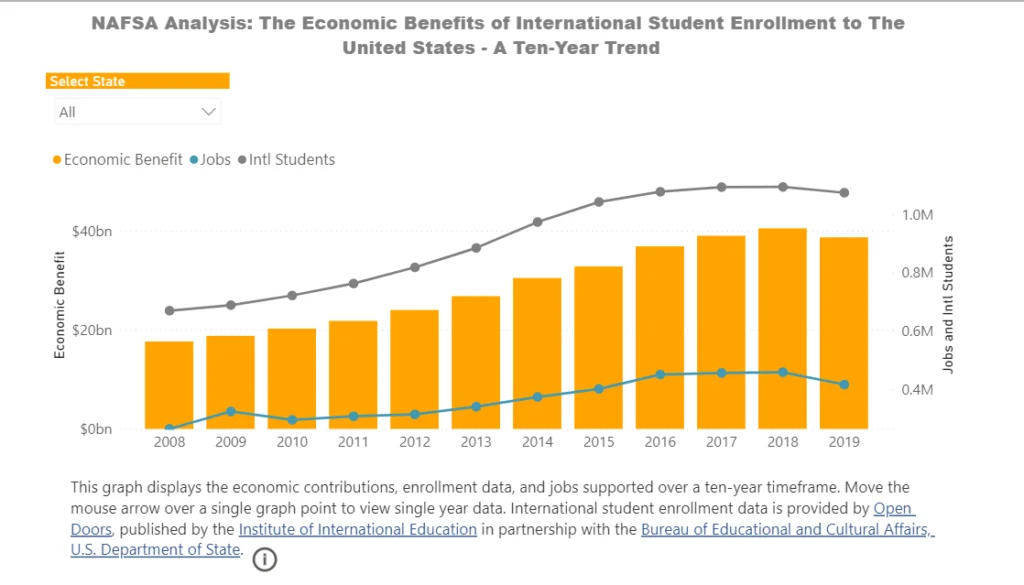Where does your global education business stand today? According to the Fall 2020 International Student Enrollment Snapshot Report by the Institute of International Education, the United States experienced a decline of 43% in new international student enrollments.
Based on NAFSA: Association of International Educators statistics, the downward trend for new international student enrollment had started pre-pandemic, around 2016.

NAFSA’s Executive Director and CEO, Esther D. Brimmer also said in a statement, “For the past four years, international students and scholars have had to endure travel bans, executive orders, detrimental regulatory actions and xenophobic rhetoric from the highest levels of U.S. government. The lack of a coordinated national pandemic response made the situation even more difficult.”
The downward spiral may come to a halt with a new administration and because of post-pandemic recovery. According to the Institute of International Education’s President, Allan E. Goodman, there will be a pent-up demand for the international education market once the pandemic ends. Will your global education business be ready once the demand kicks in?
Key Points at a Glance
- A higher education institution must be prepared to provide options to the post-pandemic education market.
- Let students know that your institution can meet the demands of a post-pandemic world.
- Disruptions can lead to innovation.
Consider your options
Once all travel restrictions have been lifted and it is “safe” to travel, international students will consider studying abroad again. What are your options to tap on this influx of international students?
What are your goals?
Establishing a solid global education marketing goal will help you increase your new student enrollment. How can you develop your global education marketing strategy?

You can set a specific goal such as having at least 50 new international student enrollments per intake. You can create your global education marketing strategy based on current trends.
If you are located in Canada, you can use the Canadian Bureau for International Education (CBIE) report as a reference for top sending countries and you can create a marketing plan geared towards catering to that market. CBIE data shows that the top sending countries were India at 34% and China at 22%.
With that data, you can start to craft your marketing plan in a way that will appeal to international students based in India or China. On the other hand, you can also target the “least” sending countries such as the Philippines, Japan, Bangladesh, Algeria, Morocco, Colombia and Mexico. CBIE data shows that international students from these countries comprise 7% (1% per country mentioned) of the total international student population in Canada.
A lower percentage of students sent abroad may indicate that their international students are not yet aware of opportunities in Canada and that is a promising market to capture.
What are your resources?
You can refer to your government’s official websites for international student data as well as higher education solutions provider websites to get the latest trends, and insights for the global education business sector.
Determine the Global Education Marketing Tool You Need
Digital marketing is one global education marketing tool that you can rely on. Your target audience is always online and their generation are mostly referred to as “digital natives” or those who grew up in the era of digitization. Investing in digital marketing would greatly help you reach your audience.
Furthermore, you can also invest in college management service providers who specialize in global education marketing. Their years of experience and industry knowledge will surely help you in growing your global education business.
Develop a Plan to Educate Yourself
If you belong to the higher education sector, you need to be up-to-date with the latest trends so you will always be a relevant competitor in the global education market. Make it a habit to brainstorm with your in-house marketing team.
You can try and host online events where you can ask your target audience what they want and what they expect from a higher education institution. Feedback from participants can be transformed to valuable insights that can help you in drafting your global education marketing strategy.
You can develop your global education marketing plan with data, as the old saying goes, straight from the horse’s mouth.
Be aware of the different types of education around the world
Aside from the system, global education can refer to the type of education a higher education institution gives. Equipping students with a global mindset will let them see the bigger picture of things. According to Ariel Tichnor-Wagner, Ph.D., a Senior Fellow of Global Competence at ASCD educators have the role of turning their schools and classrooms into “windows to the world.”
Conventional education models tie students to a specific place. During the wake of the pandemic, the conventional mode of education delivery was challenged. Now blended learning where students can study on campus and in their own homes is seen as a viable alternative for education delivery.
Also, transnational education through partner higher education institutions are now possible. A student who wants to avail of a global education can do so with less cost through a branch campus located in their own country and they can further advance their education in the main campus abroad if they meet certain eligibility requirements.
Advantages and Disadvantages of International Education
Homesickness is a constant struggle that an international student can face while studying abroad. Also, cultural differences may be a factor why students are hesitant to study in a foreign country.
Higher education institutions can provide pathways for international students to make them at ease with their move. A briefing for studying abroad can help address pre-departure jitters.
The pros of studying abroad are high quality, globally competitive education, and having a lifetime opportunity for young adults to experience and learn things for the first time. Higher education institutions, thus, have the responsibility of providing stellar education and a safe, inclusive environment for all international students.
Read more:
Bibliography
Baer, J., & Martel, Ph.D., M. (2020, November). Fall 2020 International Student Enrollment Snapshot [Fall International Enrollments Snapshot Report]. Institute of International Education. https://www.iie.org/Research-and-Insights/Open-Doors/Fall-International-Enrollments-Snapshot-Reports
Canadian Bureau for International Education. (n.d.). Where do inbound students come from? Canadian Bureau for International Education. https://cbie.ca/infographic/
India Today Web Desk. (2020, January 9). Here’s why Canada is a favourite destination for Indian students for higher studies. India Today. https://www.indiatoday.in/education-today/jobs-and-careers/story/here-s-why-canada-is-a-favourite-destination-for-indian-students-for-higher-studies-1635186-2020-01-09
Redden, E. (2020, November 16). International Student Numbers Decline. Inside Higher Ed. https://www.insidehighered.com/news/2020/11/16/survey-new-international-enrollments-drop-43-percent-fall
What is Digital Native. (n.d.). IGI Global. https://www.igi-global.com/dictionary/digital-native/7674
Why Global Education Matters. (2018, March 8). ASDC Web site. https://inservice.ascd.org/why-global-education-matters/

